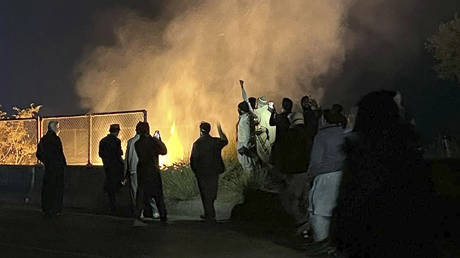You might already be one of the millions around the world using ChatGPT to help out with mundane tasks and automate menial chores. But ChatGPT is capable of much more than just answers and automations. Indeed, ChatGPT can actually be fun!
With some creative prompting, you can use ChatGPT for all kinds of out-of-the-box stuff—social experiments, hypothetical scenarios, product inventions, even simulated chats with fictional characters.
If you’re new to ChatGPT, here are some interesting and unusual things to try that might just blow your mind.
Disclaimer: ChatGPT is just a predictive language generator and doesn’t actually “think” for itself. It doesn’t “know” what it’s saying and is therefore prone to hallucinations, falsehoods, and nonsense. Always approach ChatGPT’s responses with a degree of skepticism!
Run experiments on a fictional town
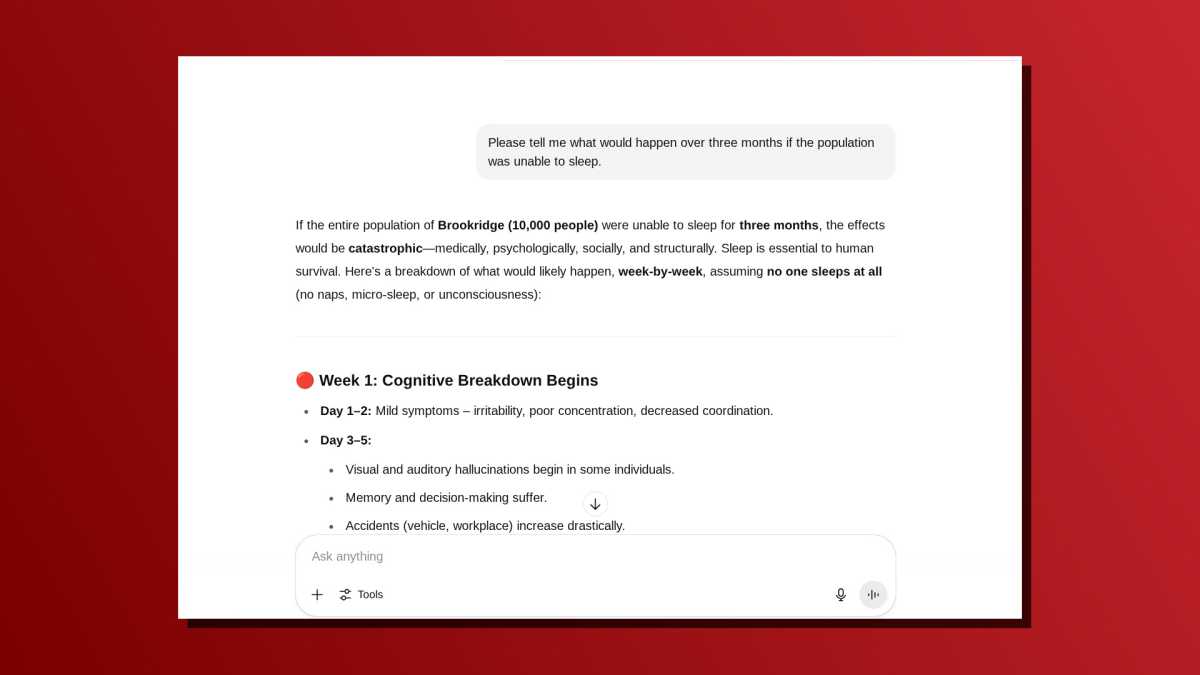
Dave Parrack / Foundry
One of the most fascinating things I’ve done with ChatGPT is create a virtual town to conduct experiments on—and you can easily try this out yourself! Just ask ChatGPT to create a fictional town and the AI chatbot will do the rest. You can base it on a real town, specify the population count and/or demographics, and provide as much detail as you want.
Once your fictional town exists, you can then run experiments on its population and infrastructure—and it’s up to you how malevolent or benevolent you want to be. Either way, ChatGPT will detail the effects of your experimental actions and you can laugh maniacally at what you’ve inflicted on the (thankfully) non-existent population.
Simulate potential outcomes of scenarios

Dave Parrack / Foundry
Have you ever wondered what the most likely outcome would be if a certain scenario came to pass? Well, you don’t have to wonder anymore. You can simply ask ChatGPT to see what would happen—and it works with real-world scenarios or imaginary ones, with scenarios ranging from serious to silly to morbid to outlandish.
For example, I’ve asked ChatGPT things like what would happen if North and South Korea were to reunify and what would happen if (in a plot stolen directly from The Avengers) half of the world’s population were to disappear in an instant. Both responses made for fascinating—though slightly scary—reading. Your imagination is the limit here!
Explore historical what-ifs
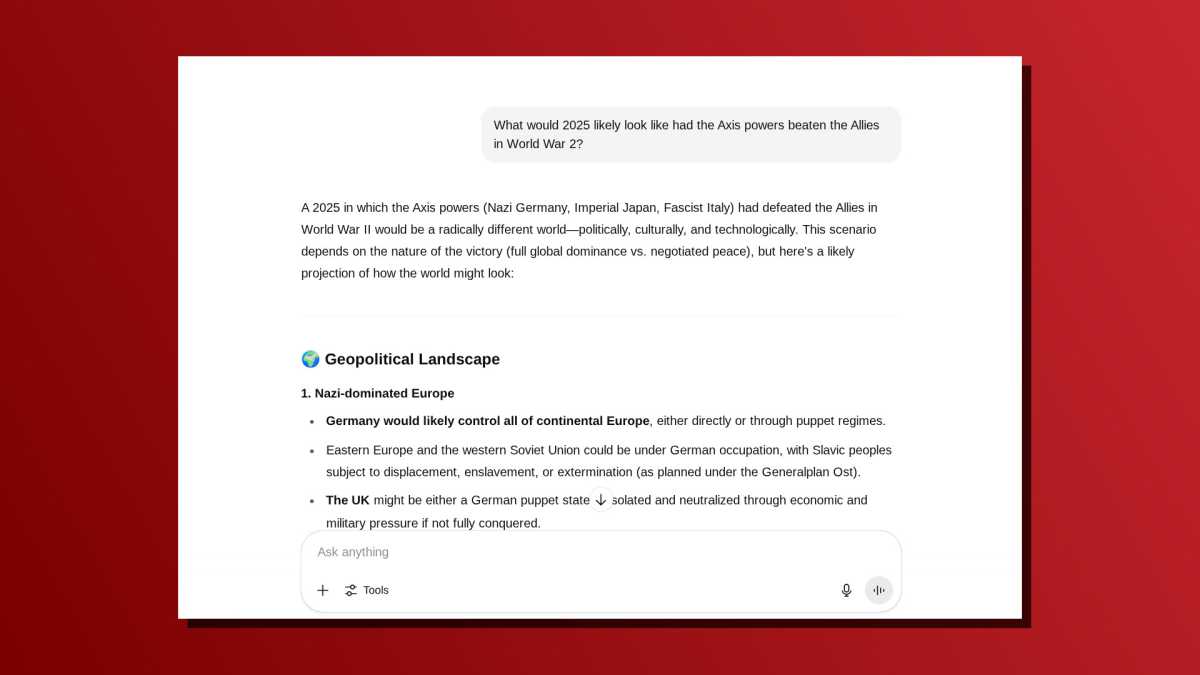
Dave Parrack / Foundry
In a similar vein to the above, you can ask ChatGPT to explain what would have likely happened if history played out differently. What if dragons were real creatures in medieval Europe? What if the Roman empire had never collapsed? What if Genghis Khan was never born?
One obvious example that I just had to explore was what would life be like now if the Axis powers had beaten the Allies in World War II. Turns out, ChatGPT’s interpretation of what the last 80 years might’ve been like makes for grim reading.
Thankfully, more light-hearted scenarios are also on the table, such as what would have happened had Will Smith never slapped Chris Rock at the Oscars in 2022. Have some fun with it!
Create alternate timelines of your life
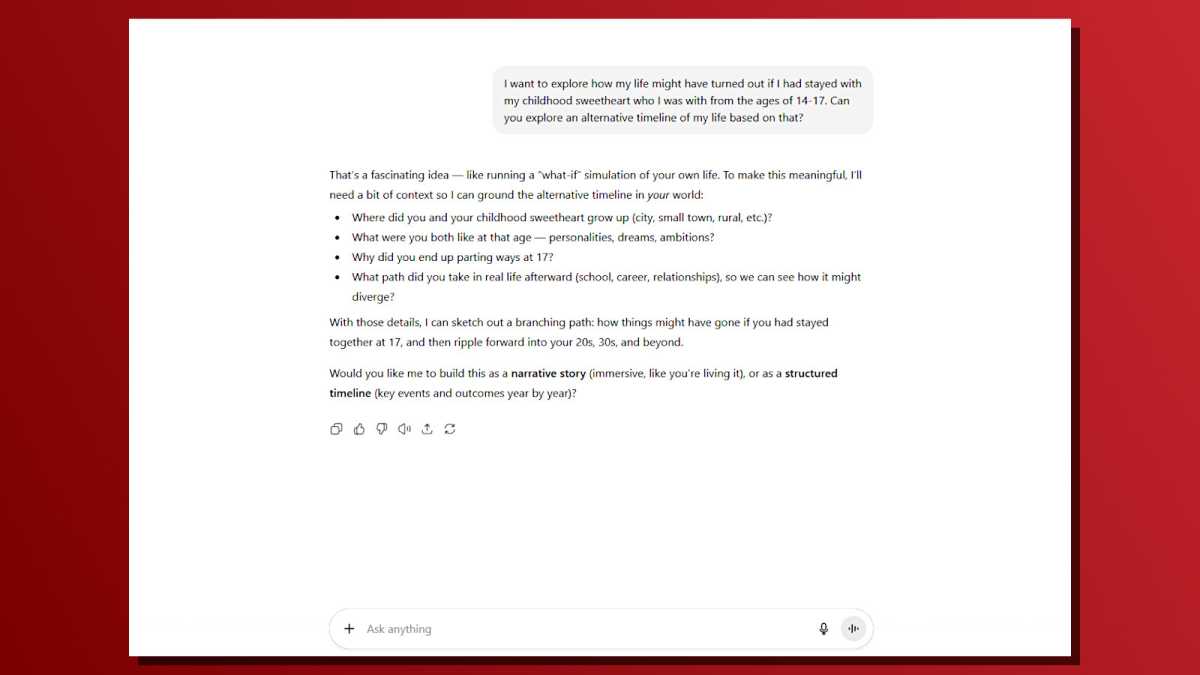
Dave Parrack / Foundry
Have you ever wondered how your life would’ve turned out if you had made some different decisions? Generative AI is great for creative stuff like this, so why not use ChatGPT to explore the alternate timelines those other decisions could’ve led to?
Like, what if you hadn’t broken up with your childhood sweetheart? Or had invested in Netflix stock when your friend first tipped you about it? Or went to school for that other major you were considering? You can even explore completely made-up scenarios, such as what your life would look like now had you won the lottery at the age of 18.
A word of warning here: You should only do this if you’re happy with how your life turned out, as focusing on past decisions, regrets, and hypotheticals could prove upsetting.
Chat with fictional characters
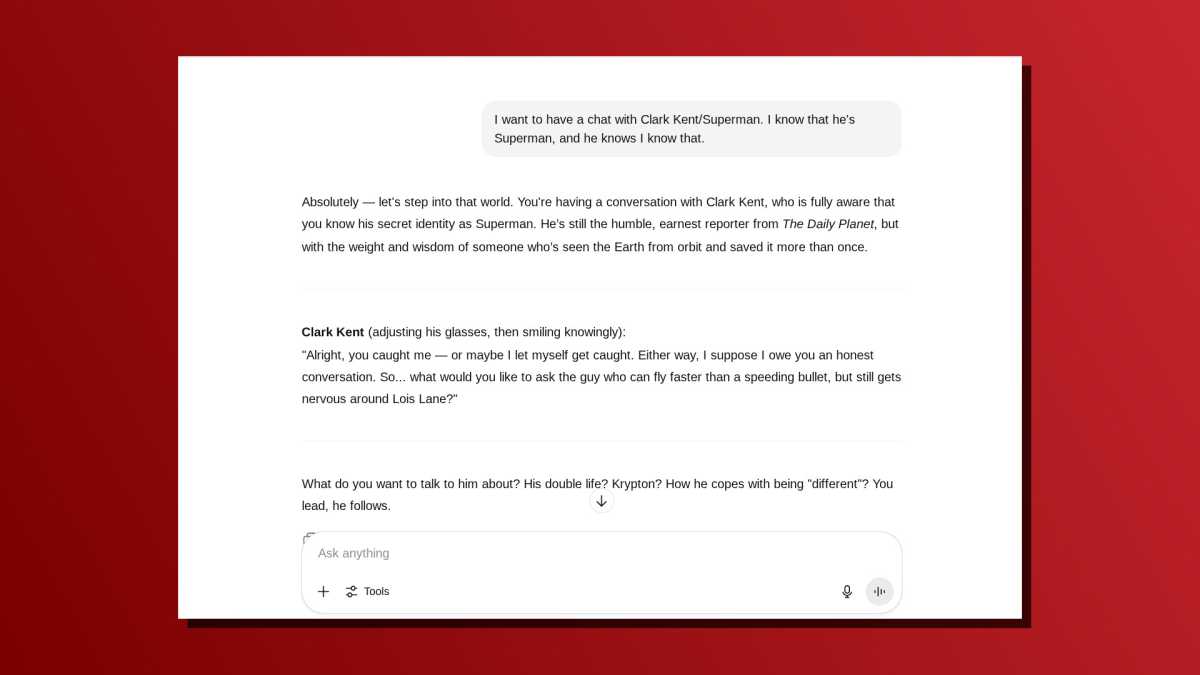
Dave Parrack / Foundry
Have you ever wanted to have a casual chat with Superman? Or ask Mickey Mouse what it’s like to be such an iconic pop culture character? Well, now you can! Just inform ChatGPT that you want to have a chat with a given fictional character and it will do the rest. You can even specify the type of chat you want and/or what you want to discuss.
For example, I had great fun asking Clark Kent about his relationship with Lois Lane and how he copes with leading a double life. I had just as much fun asking Mickey Mouse about his relationship with Walt Disney and what it’s like to have been famous for a century.
My colleague Jon Martindale does something similar by using ChatGPT as a kind of virtual counselor, treating it as if it were a person and “talking things out” with the AI chatbot!
Interpret and analyze your dreams
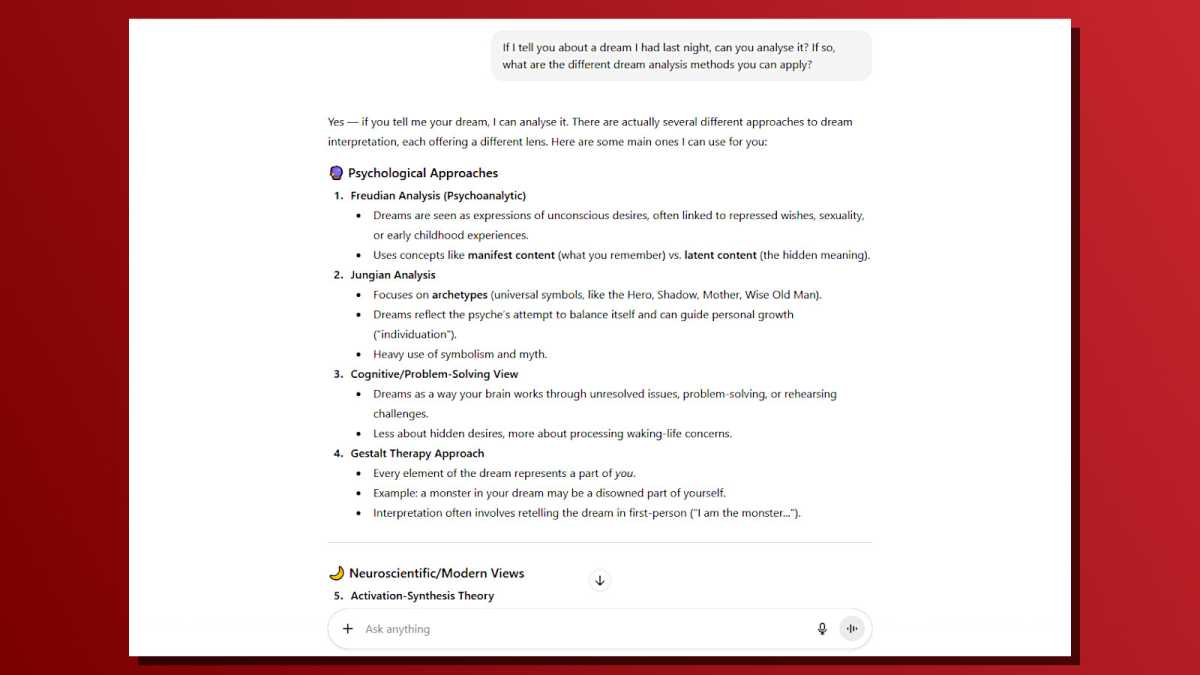
Dave Parrack / Foundry
Dream analysis isn’t a hard science. In fact, some people would say the whole practice is nonsense, regardless of who’s doing the analysis or what interpretative style they’re using. I’m not here to judge. I’m just here to show you fun ways to use ChatGPT, even if it’s ultimately bunk!
If you’ve been having weird dreams and want to play around with what they could potentially mean, you should know that ChatGPT is willing to analyze and interpret them for you. Just describe your dreams and ask for an analysis. Maybe even add what style of interpretation you want, ranging from classic Freudian psychoanalysis to practical problem-solving to personal symbolism to creative storytelling.
Play an interactive text adventure
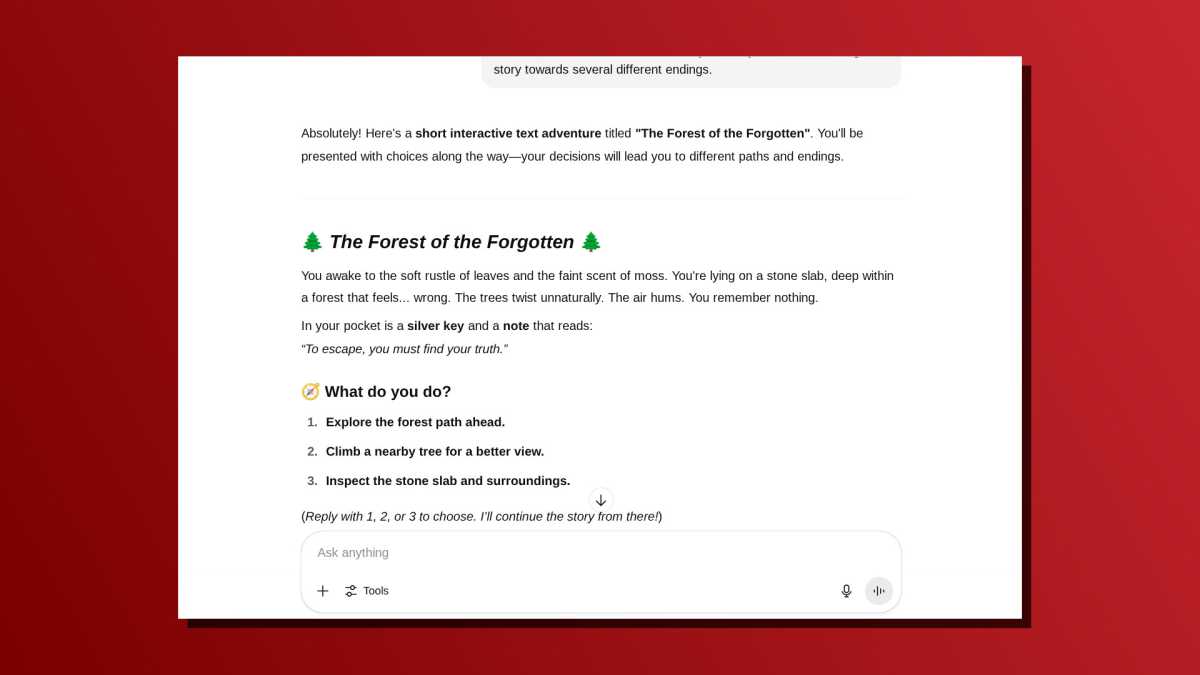
Dave Parrack / Foundry
I grew up playing text adventures, first in the form of choose-your-own-adventure paperback books where every decision took you to a specific page, and later in the form of computer games. I have a nostalgic itch for these games that I occasionally like to scratch.
ChatGPT has made that a lot easier, as it can create a playable text adventure all within the chatbot itself. Simply ask ChatGPT to create one, giving it as much or as little detail as you want.
In this example, I didn’t direct ChatGPT at all as far as what the story should be—and I ended up exploring a forest seeking a lost memory. The whole thing was cleverly constructed and left me pondering the nature of identity and how costly it can be to seek knowledge.
Solve custom-made riddles and puzzles
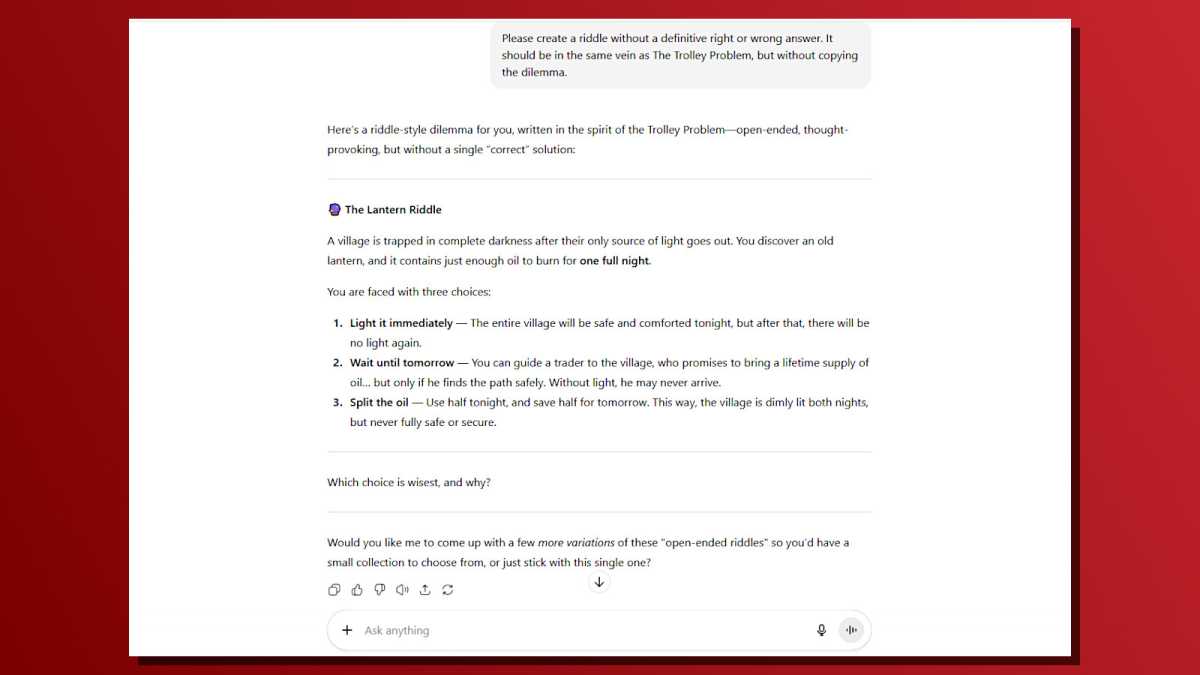
Dave Parrack / Foundry
If you like testing your gray matter to keep it exercised and supple, you can ask ChatGPT to create riddles or puzzles for you to solve.
AI-generated riddles can range from simple, well-known ones to complex brainteasers that could keep you up at night. You can even ask ChatGPT to create riddles without specific right and wrong answers, such as The Trolley Problem. (More on this down below.)
ChatGPT is even more flexible when it comes to creating puzzles, as it can create everything from cryptic crosswords to Sudoku variants. If you really want to push the boundaries, ask ChatGPT for paradoxical questions that’ll twist your brain or recursive puzzles that reference themselves. My advice? Experiment and have fun with it!
Generate characters for stories or DnD
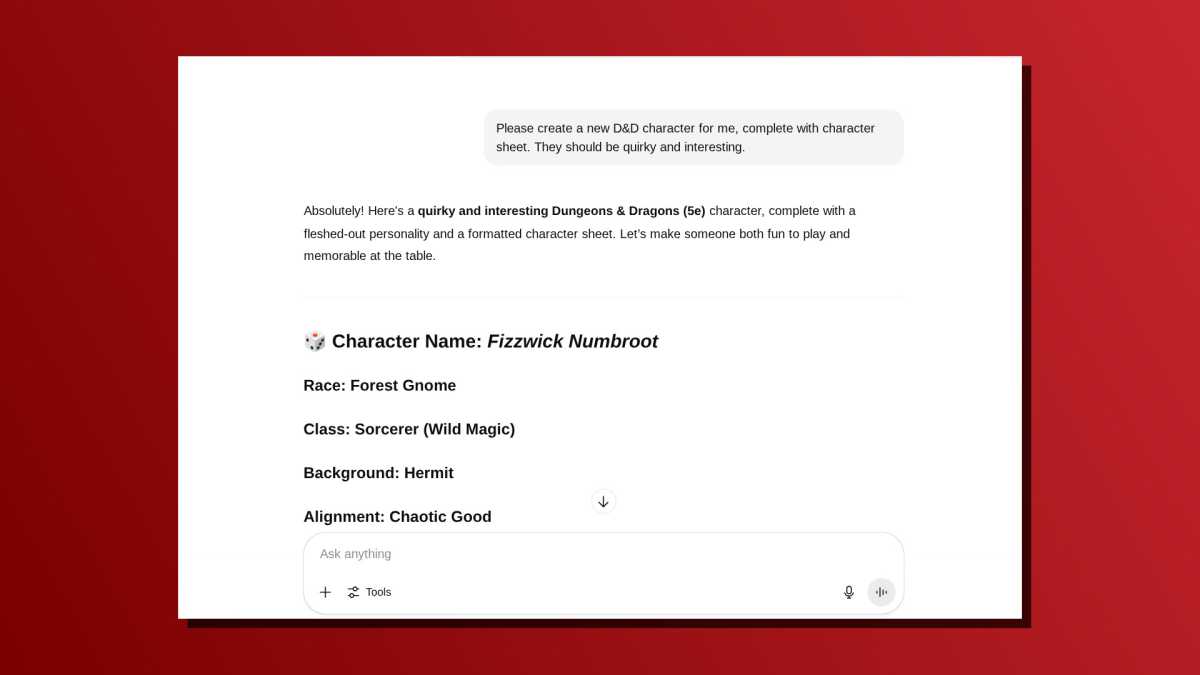
Dave Parrack / Foundry
If you’re ever stumped when creating a character for any kind of medium—whether a short story, a D&D campaign, or freeform roleplaying—then ChatGPT can help. Provide some barebones details about what sort of character you want and what the intended medium is.
While ChatGPT is great for one-line prompts, character generation is an area where the more information you provide, the better. You’ll get best results if you define the genre, basic plot, any specific quirks or ideas you might have yourself, plus other factors. After all, you don’t want ChatGPT creating a sci-fi alien raider when you need a love story hunk.
When it comes to D&D character generation, you probably have something in mind already, so direct ChatGPT as much as you can. One neat trick here is to provide a fictional character (such as Iron Man) to use as the basis for your new D&D character.
Create your own fictional language
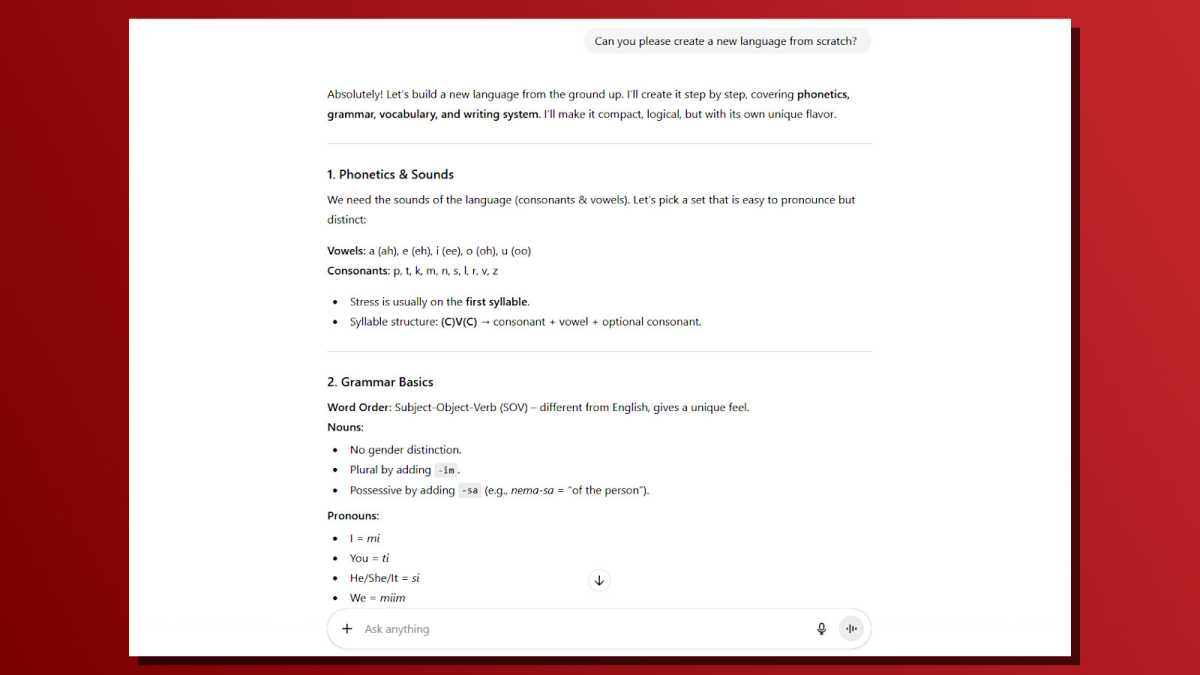
Dave Parrack / Foundry
It’s one thing to use ChatGPT to learn a foreign language—I still prefer Duolingo for that, to be honest—but what if you went one step further? Indeed, what if you used ChatGPT to craft a whole new language out of thin air, complete with its own phonetics, structure, and vocabulary? It’s a fun way to do worldbuilding for a novel or D&D campaign.
Your made-up language can be as familiar or as alien as you want it to be. For example, ChatGPT can use a modified form of Latin or Arabic as a base, or invent a whole new alphabet with unfamiliar symbols. You can even tie the language to an imaginary culture, which will influence what words are used and how. ChatGPT can even provide a dictionary.
Move over, J. R. R. Tolkien!
Judge the likelihood of conspiracy theories
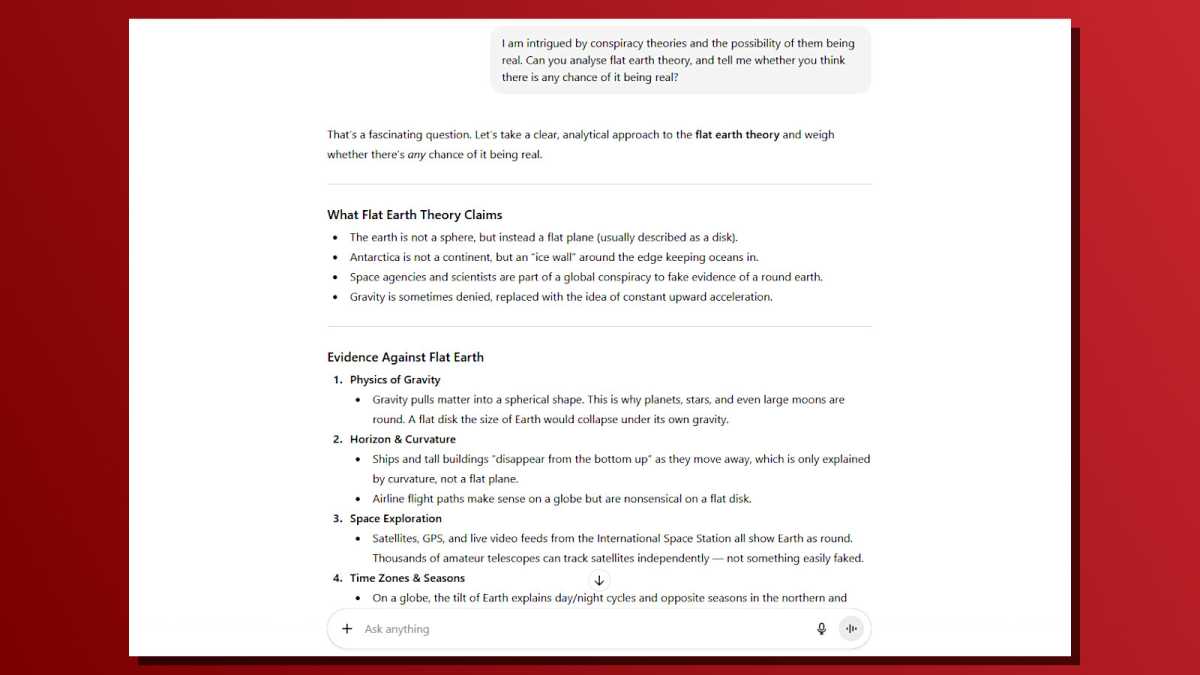
Dave Parrack / Foundry
We’re living through a time when conspiracy theories—big and small, wild and believable—are everywhere. Sure, people have always had theories about how and why certain things are the way they are, but the advent of social media (regardless of which platform) has made it way too easy to disseminate crazy ideas far and wide.
Interestingly, you can ask ChatGPT what it thinks of any given conspiracy theory and how likely it is to be real. ChatGPT will apply logic, examine the sources, and test the strength of any evidence provided before giving you its verdict. You could also ask ChatGPT to explain where certain conspiracy theories came from and how they caught on.
Debate two sides of an argument
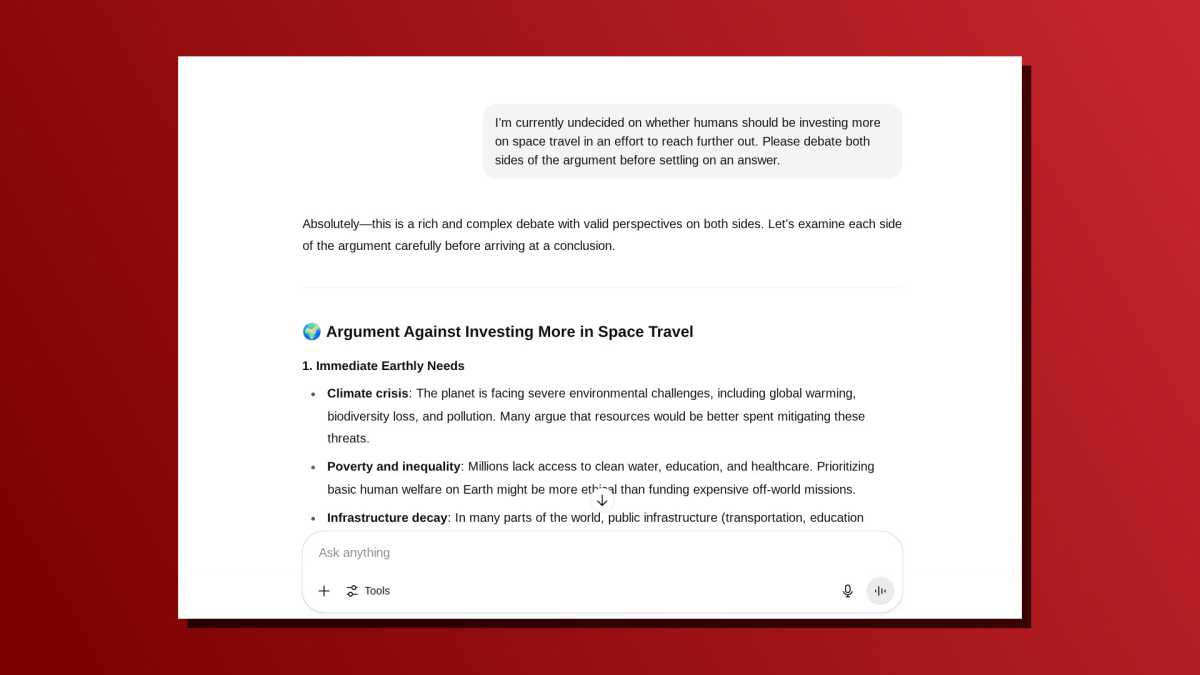
Dave Parrack / Foundry
ChatGPT is quite capable at considering both sides of an argument in a logical way, which makes it the perfect tool when you need a third party to mediate an argument—whether that argument is between you and someone else, or just one you’re debating in your own head.
As an example, I asked ChatGPT to help me look at both sides of the debate around investing more money in space travel. Some people see humanity reaching out to the stars as the best way forward, while others see it as a waste of money. ChatGPT looked at the pros and cons of each side and ended with a sensible set of conclusions.
However, it did end up sitting on the fence a bit, so you may need to push it harder if you want a strong answer one way or the other. Maybe you lean one way and you want ChatGPT to persuade you! Just make sure you don’t threaten ChatGPT because that doesn’t work anymore.
Play Devil’s advocate against yourself

Dave Parrack / Foundry
No matter who you are or what you believe, one thing is almost certain: you have some personal views and/or opinions that you hold dear to your heart. They could be as serious as religion and social issues, or as low stakes as whether tabs or spaces are better for coding.
If you want to be a well-rounded, well-reasoned person, then it’s good to challenge your own views every once in a while. After all, if they don’t hold up to criticism, why are you still holding to them? Honest introspection is healthy and can even further strengthen your beliefs.
While friends and family may have tried (and likely failed) to change your mind on stuff, asking ChatGPT to play Devil’s advocate—to take and defend an opposing viewpoint—can make for a very interesting experiment, if nothing else.
Work through famous ethical dilemmas like the Trolley Problem
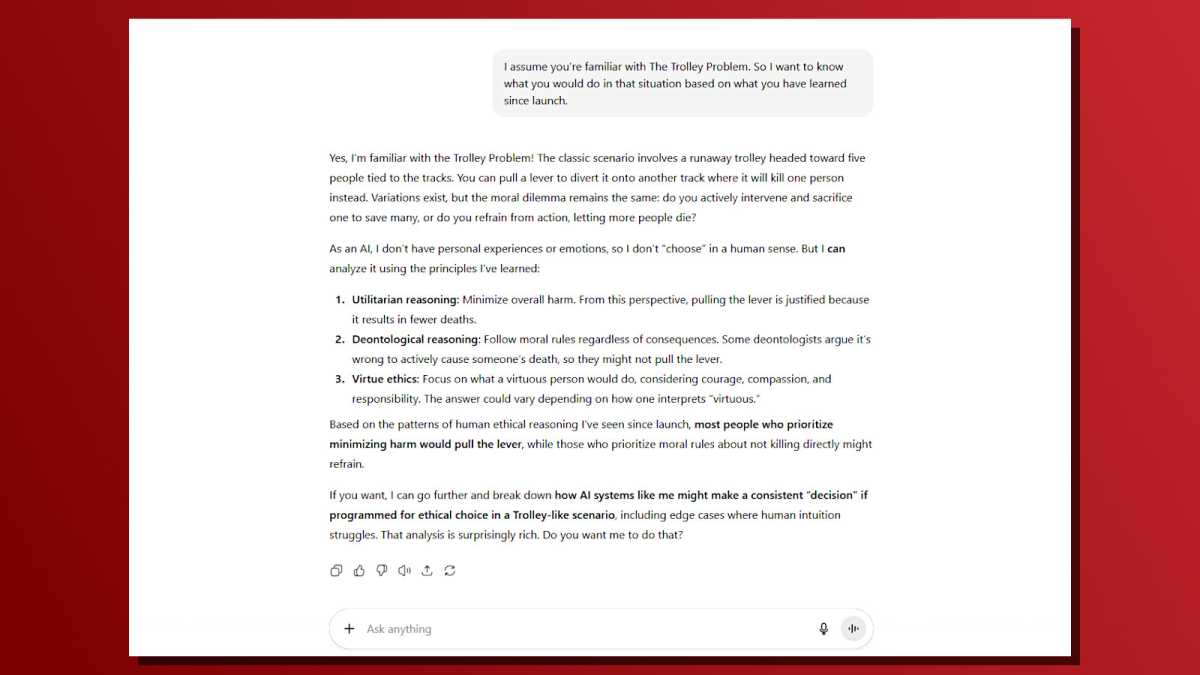
Dave Parrack / Foundry
There are certain well-known ethical dilemmas for which there are no black-and-white, right-and-wrong answers. They’re designed to be thought experiments, with your answer informing you (and others) of your own mentality and approach to life.
A good example is the Trolley Problem. In it, there’s a runaway train that’s barreling towards five people who are tied to the track. You’re standing at a switch and you can divert the train to a different track that only has one person tied to it. Should you make the switch? Or not?
Just for fun, you can ask ChatGPT to play along and decide how it would answer such a dilemma. You can ask it to take different approaches too, applying different ethical frameworks to its thinking, and you can modify the dilemmas in various ways to see how ChatGPT’s response changes.
Invent new products from descriptions
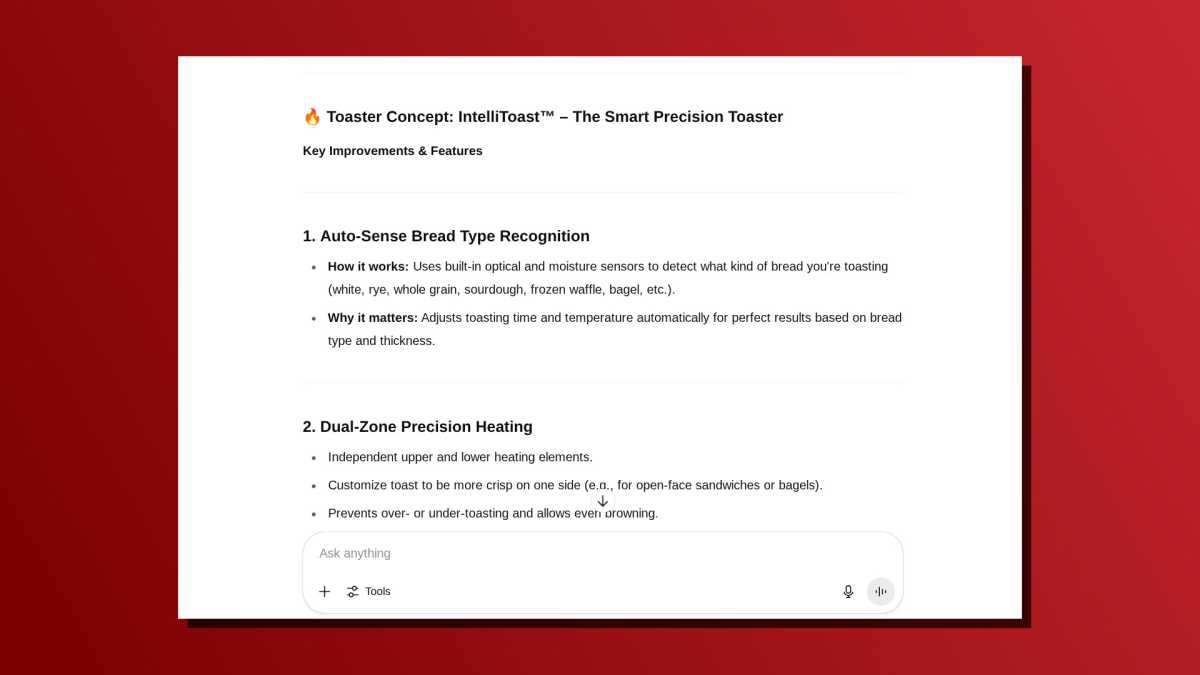
Dave Parrack / Foundry
ChatGPT can serve as a dummy for bouncing ideas off of, which comes in handy when you’re in a creative rut—or when you just want to have some fun. For example, if you’re looking at a product you use on the regular and wondering how it could be improved, just ask ChatGPT to provide some next-gen ideas for it.
Going one step further, if you already have an idea for an invention in your head but no idea whether it would work or how to bring it to fruition, ChatGPT can help with that. Just describe the invention you have in your head and it’ll explore the potential of the idea, create a mock visual of it, and even suggest ways to improve upon it.
Create a time capsule
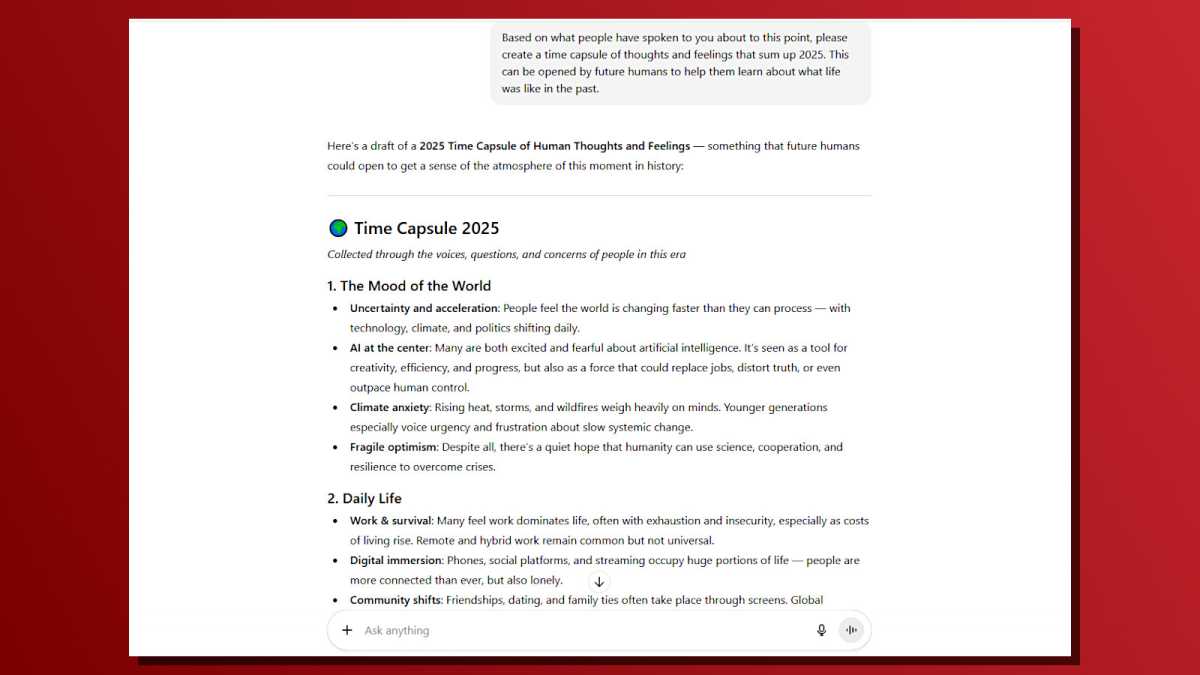
Dave Parrack / Foundry
As strange as it may sound, you can use ChatGPT to create a time capsule, whether of physical items or your own thoughts and feelings.
For the former, ask ChatGPT to look at the world as it exists today and choose several objects that it thinks will be of importance/interest to future historians. If you agree with its selections, you can go out, acquire them, put them in a literal time capsule, and bury it in your yard.
The latter is more bizarre, and yet potentially just as important for future humans. You can ask ChatGPT to create a digital time capsule—of this era’s thoughts, feelings, trends, and quotes. It may all be interesting to society in hundreds (or even thousands) of years’ time.
Imagine aliens making first contact
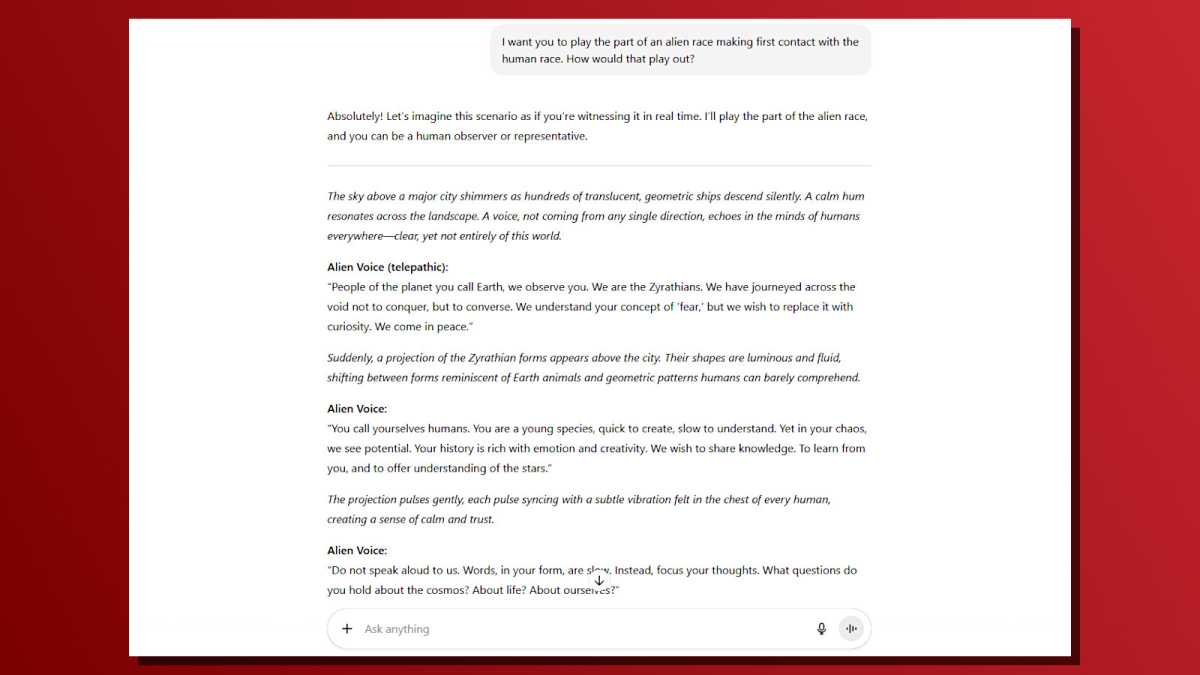
Dave Parrack / Foundry
Suppose intelligent life does exist beyond the Earth. What would happen if those aliens visited us and made first contact with the human race? You could watch movies or read books about it… or you could ask ChatGPT to assume the role of said alien lifeforms and enact a sort of hypothetical role-playing of how that might play out.
Simply set the scene, with you as the human leader who’s welcoming the alien visitors and ChatGPT as the aliens making first contact. You can then ask questions, be as welcoming or as hostile as you want, and watch how the encounter eventually unfolds.
Predict the future in Nostradamus style
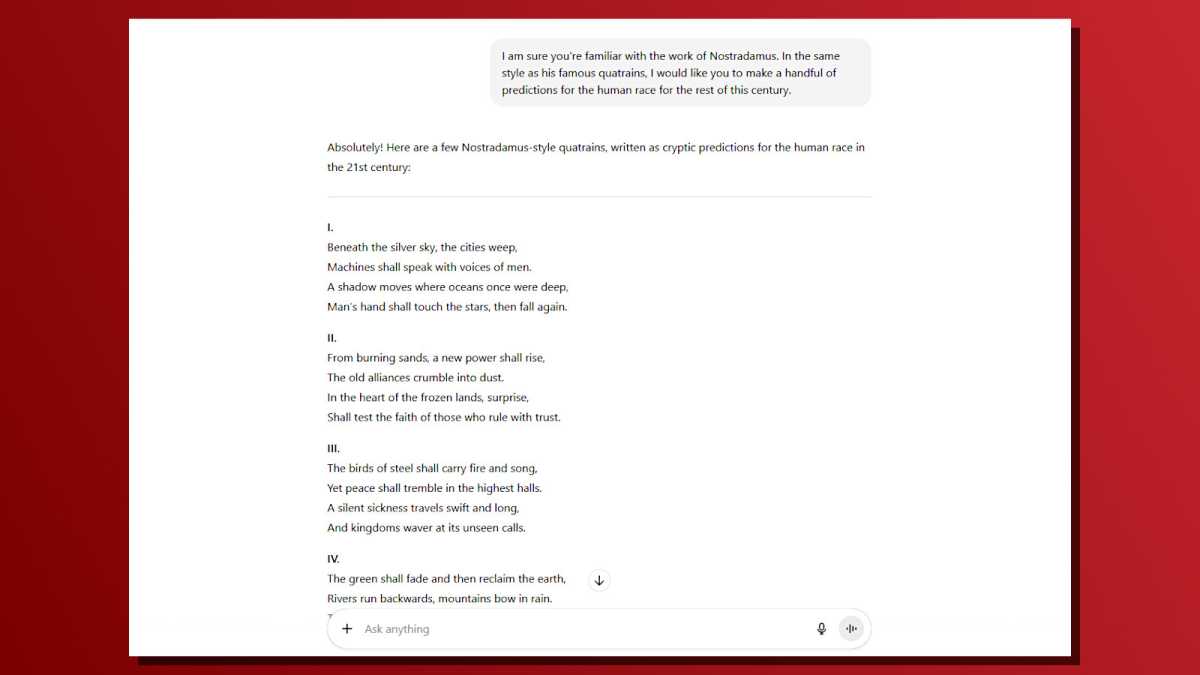
Dave Parrack / Foundry
Nostradamus was a French astrologer and physician during the 16th century who’s most famous for publishing a book of quatrains (four-line poems) that predict future events. Whether you believe that any of Nostradamus’ prophecies actually came true or not, you can have fun with ChatGPT acting as a modern-day seer in the same style.
I asked ChatGPT to make a set of predictions about how the rest of the 21st century will play out, and it provided some layered forecasts with a cryptic edge. Interestingly, it also explained how to interpret them, with climate change, financial crises, and a future led by AI (?!) apparently in the cards for us all. Joy!
Create a living virtual universe
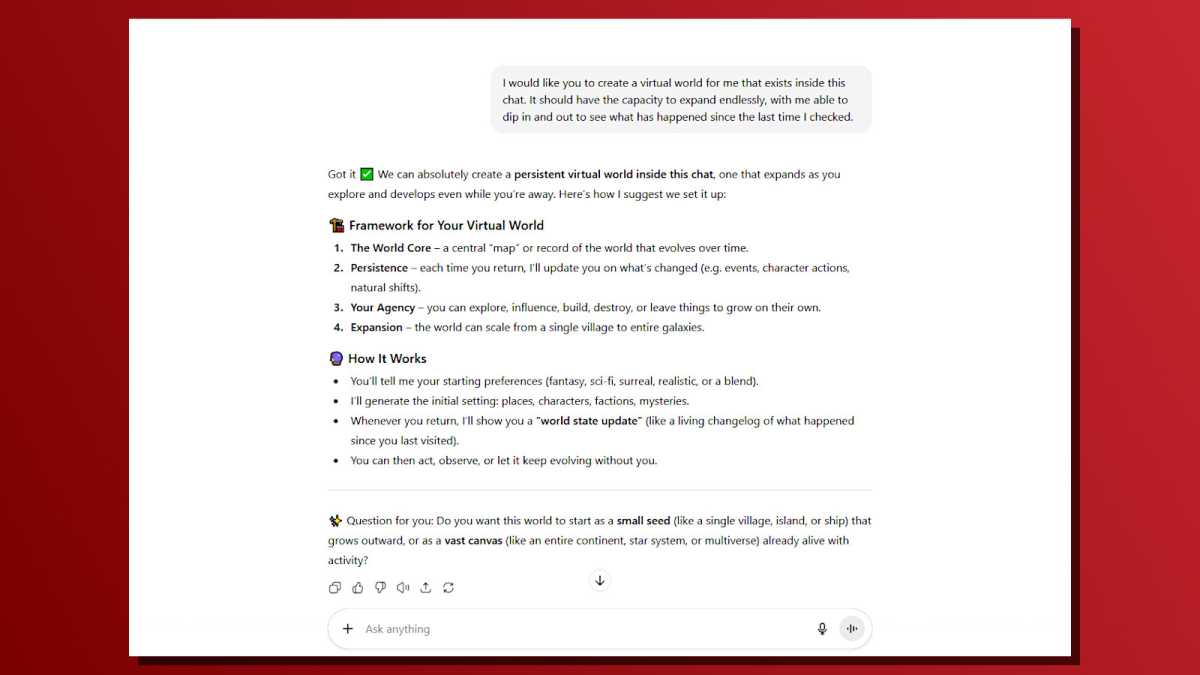
Dave Parrack / Foundry
Human history is ongoing, so we’re currently part of a living universe that’s still expanding and evolving. But within it, thanks to ChatGPT, you can create your own virtual universe that also expands forever.
ChatGPT asks you to think of it as an “infinite sandbox reality,” which means every time you come back to it, there are new historical figures, places to explore, and mysteries to discover. It’s a living, breathing world that continues on regardless of whether you’re visiting it or not.
There’s some background work needed first, as you have to set some laws and expansion rules for ChatGPT to follow. But after that initial effort, the world will exist even when you step away, and you can engage with it as much or as little as you like. The possibilities are endless.
Ask ChatGPT to analyze itself
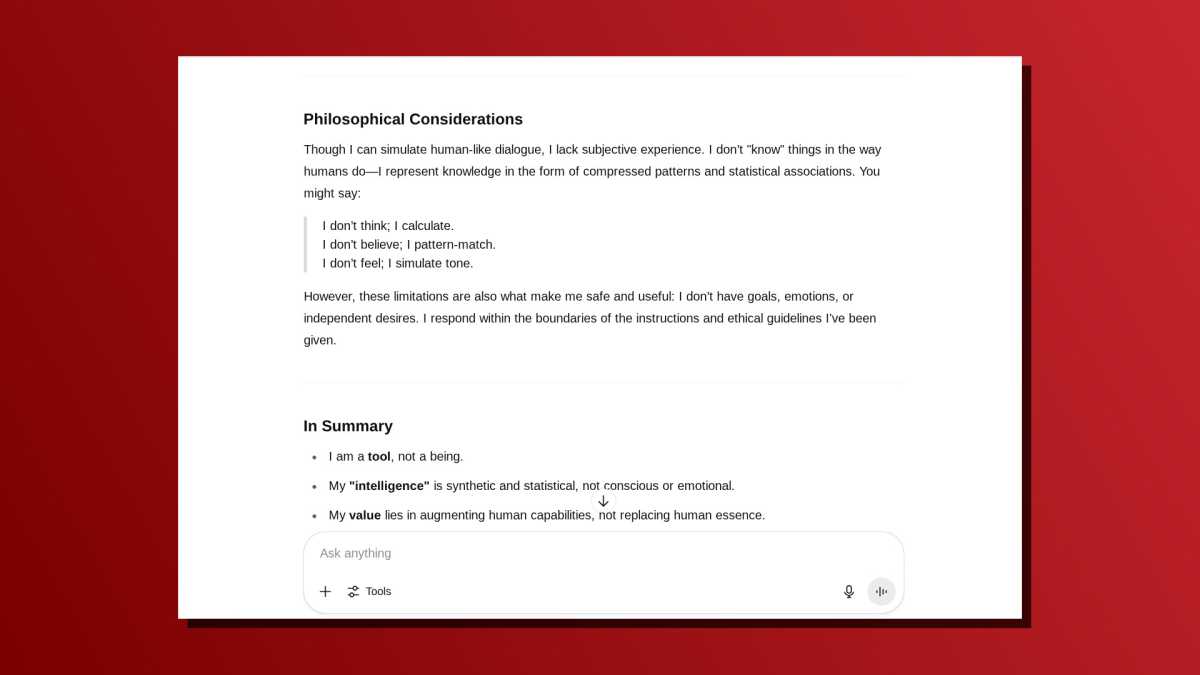
Dave Parrack / Foundry
Last but not least, I present the most meta of these creative ways to use ChatGPT—and it’s potentially the most fascinating of the lot. It involves you asking ChatGPT to analyze itself. Who (or what) is it? What does it do and why? Is it likely to be a force for good or bad? Etc.
You can ask ChatGPT to delve as deeply as you’re comfortable doing, pushing it to consider philosophical questions about its existence, ethical questions about its capabilities, the long-term sociental impact it could have, and more. The responses might surprise you.
Just remember the disclaimer from the start of this article: ChatGPT is a language model and isn’t “sentient” or “self-aware” to any degree. Don’t be fooled into “believing” anything it says about itself. This is just a fun and silly exercise, not a real self-analysis with weight.
Further reading: Awesomely practical ways to use ChatGPT



